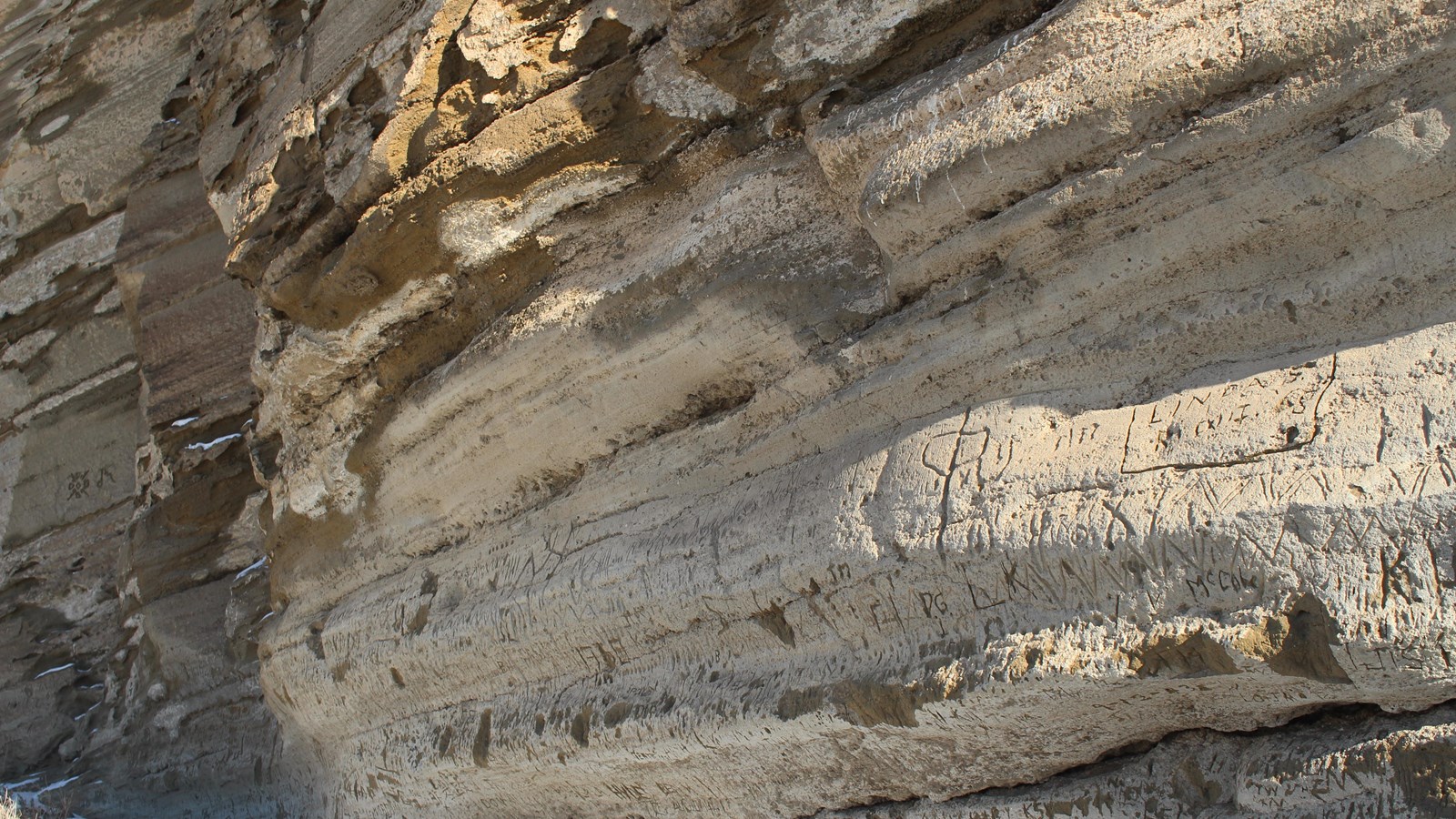Last updated: August 8, 2023
Place
Petroglyph Point, Tulelake, Ca

NPS Photo
Information - Maps Available, Information Kiosk/Bulletin Board, Parking - Auto, Restroom, Scenic View/Photo Spot, Trash/Litter Receptacles
One reason Lava Beds is such a special place to contemplate cultural history is that it contains two types of rock art, or rock imagery— carved petroglyphs and painted pictographs. All of the monument’s rock imagery is located in the traditional territory of the Modoc people and their ancestors or predecessors.
It is hard to determine the age of rock art. This is especially true of petroglyphs, since material was removed in their creation, not added. It is possible that some of these images at Lava Beds were made more that 6,000 years ago. Estimating the age of an individual petroglyph based on weathering is complicated by the number of times it may have been inundated in water as Tule Lake rose and fell around the island that later became known as Petroglyph Point. Interestingly, some of the geometric patterns found in the rock imagery here appear on household items up to 5,000 years old from nearby Nightfire Island. Could some of the same people have carved those same patterns into the rocks at Petroglyph Point? With over 5,000 individual carvings, this site is one of the most extensive representations of American Indian rock art in California—it is possible that dozens or even hundreds of generations of artists paddled out in canoes, sharp sticks or stones in hand, to leave their mark here in the soft volcanic tuff.
What Do They Mean?
Unlike rock art in other areas of the West, images here seem to be dominated by geometric patterns instead of depictions of people and animals. Looking at the images at Lava Beds, most visitors can’t help but imagine what such patterns might mean. Unfortunately, historic events in this area have made gathering information difficult. Before the Modoc War caused tribal fracturing and the removal of the Lava Beds’ band of Modocs to Oklahoma, no ethnographic study was ever done with Modoc peoples to record their stories about images they may have been familiar with or their beliefs about images left behind by even earlier peoples. Today, it is probable that some knowledge surrounding the rock imagery of the lava beds is not shared with those on the outside.
Still, many visitors to rock art sites come away feeling they are very special places, places that perhaps even reach across time and culture to speak to universal human experiences. Petroglyph Point is the center of a Modoc creation story, while other sites with pictographs hold traditional significance for some modern Modoc and Klamath people. Were only individuals holding important positions in the tribe permitted to create rock art at some places on certain occasions? Were other images created in association with special activities to mark important points in a a person’s life? Though each observer can imagine in his or her own mind what circumstances and meaning might have led to the creation of each image, only each original artist, long gone, knows for sure.
Help Protect Rock Art!
Visitors to the rock art sites of Lava Beds may notice that these places have not always been respected in modern times. Vandalism significantly mars some sites, especially Petroglyph Point. This type of activity unfortunately reflects the disrespect of a few for a cultural history that belongs to us all— a history that the National Park Service is mandated to protect.
Though a chain-link fence was installed in the 1930s at Petroglyph Point to provide some protection to the images, pictographs at other sites depend upon the personal responsibility of each visitor to look but not touch. The oil on our hands can cause damage to the delicate images. You can help protect these treasures by reporting any inappropriate activity you see at rock art sites to a ranger or other law enforcement officer as soon as possible.
You may also notice painted markings left in lava tube caves by early explorers and even a few Japanese characters carved into the boulders at Petroglyph Point by interned Japanese-Americans during World War II. Though visitors may wonder why some markings are protected and others are considered graffiti, consider that hundreds of thousands of people now visit here annually! What would Lava Beds look like if each person left their mark— and what would remain of ancient rock art? Though someday nature will reclaim each image left behind by the Modoc and earlier peoples, each of us has the opportunity not only to open our minds to their wonder and mystery, but also to do our part to protect this heritage for future generations. We thank you for appreciating and respecting these very special places and for helping others do the same.
A Haven For Raptors
High out of reach of predators and humans, the pocketed cliff face of Petroglyph Point provides an ideal perch for raptors and other birds. From early spring through early fall, look for large nests and droppings that indicate the presence of young falcons, hawks, and owls. You can also spot cliff swallow chicks peering from clusters of small, round mud nests.
From the wetlands of Tule Lake to Ponderosa pine forests along Lava Beds’ southern boundary, the area’s diverse range of habitats offer excellent hunting opportunities for highly adapted birds of prey. A prairie falcon might fly ten miles per day on streamlined wings to hunt smaller upland birds, while a barn owl uses offset ears and silent feathers to locate and catch grassland rodents at night.
Protected lands in this area provide both temporary and year- round homes for rare and threatened raptors. Hundreds of bald eagles winter here, and an occasional peregrine falcon stops to rest along its epic migration between North and South America.
